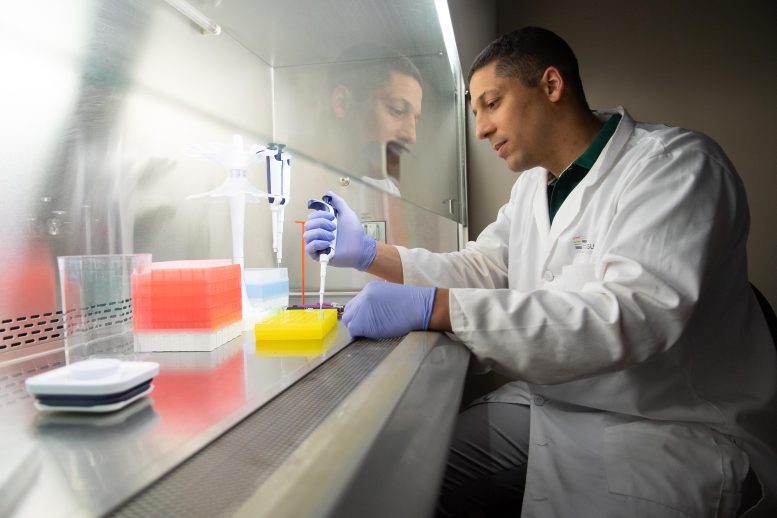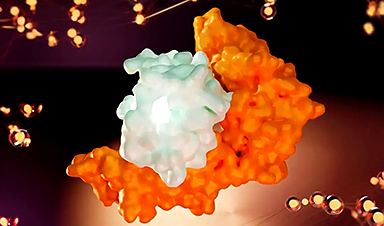New study shows that common genetic variation among people is responsible for mediating SARS-CoV-2 asymptomatic infection.
Have you ever wondered why some people never became sick from COVID-19? A study published recently in the journal Nature shows that common genetic variation among people is responsible for mediating SARS-CoV-2 asymptomatic infection. The results indicate that individuals having this variant never feel sick once infected. This exciting discovery was a result of a U.S.-Australia collaborative work led by Danillo Augusto, Ph.D., assistant professor at the University of North Carolina at Charlotte; Jill Hollenbach, Ph.D., professor at the University of California San Francisco; and Stephanie Gras, professor at La Trobe University in Australia.
The Role of Human Leukocyte Antigens (HLA)
The study focuses on a group of genes called human leukocyte antigens (HLA). These HLA genes code for proteins used by the immune system to identify your healthy cells and distinguish them from those infected by bacteria and viruses. The HLA system is critical for immune response and also highly variable among individuals. Because of the role of HLAs in fighting infection, the researchers wondered if there were specific variants that would make us more protected or susceptible to SARS-CoV-2 virus.

Danillo Augusto, assistant professor of Biological Sciences at UNC Charlotte. Credit: UNC Charlotte
Research Findings and Methodology
Hollenbach led the data collection, which started at the beginning of the pandemic. First, 29,947 unvaccinated individuals were screened using a mobile app designed specifically to track COVID-19 symptoms, and 1,428 reported a positive test for the virus. All individuals had their DNA previously sequenced to analyze their HLA genes. The researchers found that individuals having the genetic variant HLA-B*15:01 were much more likely to remain asymptomatic after infection. Impressively, this variant is present in about 10% of the population. In summary, individuals who had HLA-B*1501 in their genome could not dodge the infection, however, they escaped being sick.
Insights on Immune Response
“We hypothesized that their immune system could react so fast and powerfully that the virus was eliminated before causing any symptoms. It’s like having an army that already knows what to look for and can tell by the uniform that these are the bad guys,” according to Hollenbach.
HLA molecules display pieces of the virus to immune effector cells for inspection. The study used cells from individuals with HLA-B*15:01 who donated blood several years before the pandemic. The results showed that those individuals had memory T cells against a specific particle of SARS-CoV-2. Individuals who never had any contact with SARS-CoV-2 had already had some kind of previous exposure to other viruses and developed immunological memory against a particle from SARS-CoV-2.
Their immunological memory would elicit a much faster response and explain why those individuals remained asymptomatic. Still, it remained intriguing how they could develop immunological memory against SARS-CoV-2 without ever being exposed to this virus.
Cross-Reactive Immunological Responses
“It is widely known that other types of coronaviruses have caused seasonal colds for decades. We hypothesized that these individuals were exposed to seasonal coronaviruses in the past, and somehow, individuals specifically carrying HLA-B*15:01 could quickly kill cells infected by SARS-CoV-2 due to cross-reactive immunological responses. So, even if the bad guys changed the uniform, the army would still be able to identify them by their boots or maybe a tattoo on their arms. That is how our immunological memory works to keep us healthy,” said Augusto.
After carefully analyzing the genomic sequences of all coronaviruses, the study showed that this SARS-CoV-2 particle recognized by HLA-B*15:01 in unexposed individuals is very similar to viral particles from other previous coronaviruses. The research demonstrated that T cells from pre-pandemic individuals could identify viral particles from past coronaviruses and SARS-CoV-2 with the same efficiency by showing crystal structures and affinity assays. It means those individuals created immunological memory for the previous coronaviruses, but because of the high similarity of this viral particle, their memory T cells can also recognize and kill SARS-CoV-2 very fast.
Implications and Future Research
The results show a mechanism for how individuals can avoid being sick from SARS-CoV-2 and the research group plans to continue learning about the response against this virus, which will result in better understanding of COVID-19 therapeutics and vaccines.
For more on this research, see Unmasking the Secret of COVID-19 “Super Dodgers.”
Reference: “A common allele of HLA is associated with asymptomatic SARS-CoV-2 infection” by Danillo G. Augusto, Lawton D. Murdolo, Demetra S. M. Chatzileontiadou, Joseph J. Sabatino Jr, Tasneem Yusufali, Noah D. Peyser, Xochitl Butcher, Kerry Kizer, Karoline Guthrie, Victoria W. Murray, Vivian Pae, Sannidhi Sarvadhavabhatla, Fiona Beltran, Gurjot S. Gill, Kara L. Lynch, Cassandra Yun, Colin T. Maguire, Michael J. Peluso, Rebecca Hoh, Timothy J. Henrich, Steven G. Deeks, Michelle Davidson, Scott Lu, Sarah A. Goldberg, J. Daniel Kelly, Jeffrey N. Martin, Cynthia A. Vierra-Green, Stephen R. Spellman, David J. Langton, Michael J. Dewar-Oldis, Corey Smith, Peter J. Barnard, Sulggi Lee, Gregory M. Marcus, Jeffrey E. Olgin, Mark J. Pletcher, Martin Maiers, Stephanie Gras and Jill A. Hollenbach, 19 July 2023, Nature.
DOI: 10.1038/s41586-023-06331-x
News
AI matches doctors in mapping lung tumors for radiation therapy
In radiation therapy, precision can save lives. Oncologists must carefully map the size and location of a tumor before delivering high-dose radiation to destroy cancer cells while sparing healthy tissue. But this process, called [...]
Scientists Finally “See” Key Protein That Controls Inflammation
Researchers used advanced microscopy to uncover important protein structures. For the first time, two important protein structures in the human body are being visualized, thanks in part to cutting-edge technology at the University of [...]
AI tool detects 9 types of dementia from a single brain scan
Mayo Clinic researchers have developed a new artificial intelligence (AI) tool that helps clinicians identify brain activity patterns linked to nine types of dementia, including Alzheimer's disease, using a single, widely available scan—a transformative [...]
Is plastic packaging putting more than just food on your plate?
New research reveals that common food packaging and utensils can shed microscopic plastics into our food, prompting urgent calls for stricter testing and updated regulations to protect public health. Beyond microplastics: The analysis intentionally [...]
Aging Spreads Through the Bloodstream
Summary: New research reveals that aging isn’t just a local cellular process—it can spread throughout the body via the bloodstream. A redox-sensitive protein called ReHMGB1, secreted by senescent cells, was found to trigger aging features [...]
AI and nanomedicine find rare biomarkers for prostrate cancer and atherosclerosis
Imagine a stadium packed with 75,000 fans, all wearing green and white jerseys—except one person in a solid green shirt. Finding that person would be tough. That's how hard it is for scientists to [...]
Are Pesticides Breeding the Next Pandemic? Experts Warn of Fungal Superbugs
Fungicides used in agriculture have been linked to an increase in resistance to antifungal drugs in both humans and animals. Fungal infections are on the rise, and two UC Davis infectious disease experts, Dr. George Thompson [...]
Scientists Crack the 500-Million-Year-Old Code That Controls Your Immune System
A collaborative team from Penn Medicine and Penn Engineering has uncovered the mathematical principles behind a 500-million-year-old protein network that determines whether foreign materials are recognized as friend or foe. How does your body [...]
Team discovers how tiny parts of cells stay organized, new insights for blocking cancer growth
A team of international researchers led by scientists at City of Hope provides the most thorough account yet of an elusive target for cancer treatment. Published in Science Advances, the study suggests a complex signaling [...]
Nanomaterials in Ophthalmology: A Review
Eye diseases are becoming more common. In 2020, over 250 million people had mild vision problems, and 295 million experienced moderate to severe ocular conditions. In response, researchers are turning to nanotechnology and nanomaterials—tools that are transforming [...]
Natural Plant Extract Removes up to 90% of Microplastics From Water
Researchers found that natural polymers derived from okra and fenugreek are highly effective at removing microplastics from water. The same sticky substances that make okra slimy and give fenugreek its gel-like texture could help [...]
Instant coffee may damage your eyes, genetic study finds
A new genetic study shows that just one extra cup of instant coffee a day could significantly increase your risk of developing dry AMD, shedding fresh light on how our daily beverage choices may [...]
Nanoneedle patch offers painless alternative to traditional cancer biopsies
A patch containing tens of millions of microscopic nanoneedles could soon replace traditional biopsies, scientists have found. The patch offers a painless and less invasive alternative for millions of patients worldwide who undergo biopsies [...]
Small antibodies provide broad protection against SARS coronaviruses
Scientists have discovered a unique class of small antibodies that are strongly protective against a wide range of SARS coronaviruses, including SARS-CoV-1 and numerous early and recent SARS-CoV-2 variants. The unique antibodies target an [...]
Controlling This One Molecule Could Halt Alzheimer’s in Its Tracks
New research identifies the immune molecule STING as a driver of brain damage in Alzheimer’s. A new approach to Alzheimer’s disease has led to an exciting discovery that could help stop the devastating cognitive decline [...]
Cyborg tadpoles are helping us learn how brain development starts
How does our brain, which is capable of generating complex thoughts, actions and even self-reflection, grow out of essentially nothing? An experiment in tadpoles, in which an electronic implant was incorporated into a precursor [...]





















